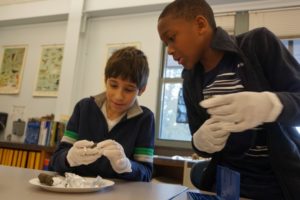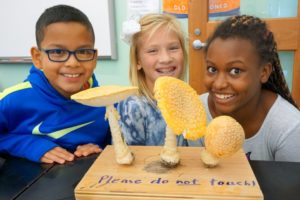by Teacher Peter Manzelmann
Friends School Mullica Hill has been rolling up its sleeves and exploring the natural world! Check out some of the amazing things our students have been studying:
 Owl Pellets – This year I am having our students dissect and investigate owl pellets. Owls are nighttime predators with all sorts of fabulous adaptations to make them superb at catching prey in the dark. I remember dissecting a pellet in my youth and was VERY surprised at what I found! Owls catch their prey and swallow it whole. Sometime later they spit up a pellet with the fur and bones of its prey. So I ordered barn owl (Tyto alba) pellets from a place in Washington State and began the investigation with my first trimester ODL classes (Outdoor Learning). The result has been fascinating. With toothpicks and dissecting tools students have been carefully picking away at the pellets and finding complete skeletons with skulls, teeth, and bones of various rodents (mice, shrews, and moles). Students are discovering that they have similar bones only much, much larger.
Owl Pellets – This year I am having our students dissect and investigate owl pellets. Owls are nighttime predators with all sorts of fabulous adaptations to make them superb at catching prey in the dark. I remember dissecting a pellet in my youth and was VERY surprised at what I found! Owls catch their prey and swallow it whole. Sometime later they spit up a pellet with the fur and bones of its prey. So I ordered barn owl (Tyto alba) pellets from a place in Washington State and began the investigation with my first trimester ODL classes (Outdoor Learning). The result has been fascinating. With toothpicks and dissecting tools students have been carefully picking away at the pellets and finding complete skeletons with skulls, teeth, and bones of various rodents (mice, shrews, and moles). Students are discovering that they have similar bones only much, much larger.
 Giant Fungi – Last week Teacher Glenn discovered three enormous mushrooms that were popping up out of the ground near his home. He brought them to school to show the kids and to connect them to a lesson he was teaching. These particular mushrooms were the Fly Agaric (Anamita muscaria). They are common and widespread in the local woods, meadows, and pastures and grow to 6” inches tall and with a large cap 3 -7” in width. The ones Glenn had were huge and impressive. The cap is rounded at first but becomes flatter and brightly colored above (yellow to red). This poisonous fungus also has white gills and stems.
Giant Fungi – Last week Teacher Glenn discovered three enormous mushrooms that were popping up out of the ground near his home. He brought them to school to show the kids and to connect them to a lesson he was teaching. These particular mushrooms were the Fly Agaric (Anamita muscaria). They are common and widespread in the local woods, meadows, and pastures and grow to 6” inches tall and with a large cap 3 -7” in width. The ones Glenn had were huge and impressive. The cap is rounded at first but becomes flatter and brightly colored above (yellow to red). This poisonous fungus also has white gills and stems.
Which leads me to share that the moist, cool days of late summer and fall bring this proliferation of fruiting fungi to the forests that surround us. The fungi we see (like the mushrooms Glenn displayed) are only the fruiting structure. The much larger, vegetative part of a fungus is the mycelium extending throughout the organic matter on the forest floor. This mycelium consists of branching threadlike hyphae that interconnect to create a vast network in the soil, in rotting logs, and under tree bark. Fun fact – In 1998, scientists found enormous honey mushroom mycelium that spread over 2384 acres in Oregon and dated to be at least 2400 yrs. old. WOW! In addition to fungi’s fascinating symbiotic relationships, they are essential in their role as decomposers. Thanks, Glenn!
 Woolly Caterpillars –Have you ever asked yourself, “Why do woolly caterpillars cross the road?” Good question! These very familiar creatures, especially to children, are most common this time of year. They can be picked up gently with out harming either human or insect. Their wonderful method of rolling up into a tight ball is great protection from predators (yuck! a mouthful of fur). These are the caterpillars with the orange middle stripe and black at either end and eventually turn into the Isabella Tiger Moth. They are most conspicuous around the time of the first frost. There was one crawling above the door at the Hanshi entrance last week.
Woolly Caterpillars –Have you ever asked yourself, “Why do woolly caterpillars cross the road?” Good question! These very familiar creatures, especially to children, are most common this time of year. They can be picked up gently with out harming either human or insect. Their wonderful method of rolling up into a tight ball is great protection from predators (yuck! a mouthful of fur). These are the caterpillars with the orange middle stripe and black at either end and eventually turn into the Isabella Tiger Moth. They are most conspicuous around the time of the first frost. There was one crawling above the door at the Hanshi entrance last week.
Why they wander is puzzling to scientists because the Woolly Bear can eat virtually anything and place themselves at risk when moving around. It might be because they are “speed racers” in larval world. They can walk up to four feet per minute, or one-half mile per hour. That is very fast for a caterpillar. They can cover a lot of ground looking for a place, which will provide adequate protection from predators as well as sudden temperature changes like the one we just had. The “rural legend” that the width of the orange band can be used as a predictor of the severity of coming winter is from all accounts unreliable. Sorry!
 The Mysterious “Moss” Bug – Last week, at the end my duties at the crosswalk, a school parent said that their child had found this interesting bug near where the cars are parked. With the family in tow, we went to investigate this creature. The insect was about a quarter of an inch in size and looked like a piece of lichen or moss camouflaged on the bark of the locust tree. Bizarre looking! The parent commented that she had never seen so much interest in a tiny insect!
The Mysterious “Moss” Bug – Last week, at the end my duties at the crosswalk, a school parent said that their child had found this interesting bug near where the cars are parked. With the family in tow, we went to investigate this creature. The insect was about a quarter of an inch in size and looked like a piece of lichen or moss camouflaged on the bark of the locust tree. Bizarre looking! The parent commented that she had never seen so much interest in a tiny insect!
Well, listen to this! This creature was the larvae from a female green lacewing (a common, slow-flying insect that often come out to lights at night). Upon further investigation, the larvae’s venom loaded, prey-liquefying fangs spear its’ victims and then tosses the debris onto its bristle-coated body. During the three-week feeding spree, these pieces of debris consist of bits of lichen and moss, tree bark, and even the husks from its prey. It pulls these materials together forming this weird camouflage “backpack”. This habit of recycling debris and insect remains earned the green lacewing larvae the nickname “trash bug”. It looked like nothing but an amazing creature “doing its thing” right before our eyes. Special “thanks” to Finn, Landon, and Kristin for this neat discovery!



Follow and Contact Us